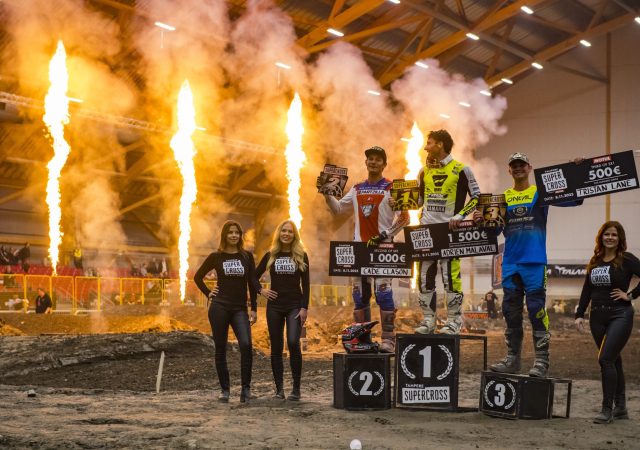For part two of Moto Gear History, Matthes and I are going to look back at Answer Racing in the 1990s.
For part two of Moto Gear History, Matthes and I are going to look back at Answer Racing in the 1990s.
In this installment, we are once again going to focus on Answer’s advertising through the decade. By doing this, we can get a nice look at both the products they offered and their changing focus throughout the nineties. In case you missed part one, where we covered Answer in the 1980s, you can click HERE to give it a read.
By the end of the 1980s, Answer had established itself as both a hard parts powerhouse and a major player in the gear industry. Stylish designs, bold colors and made-in-the-USA quality helped the company based in Valencia, California stand out in a crowded field.
As the brand moved into the new decade, it once again became time to transition to new talent as long-time sponsored riders like Bob Hannah and Johnny O’Mara moved out of the spotlight and into retirement. There was also a major influx of new technology in the early nineties, as new materials and innovative designs pushed both protection and style in new directions.
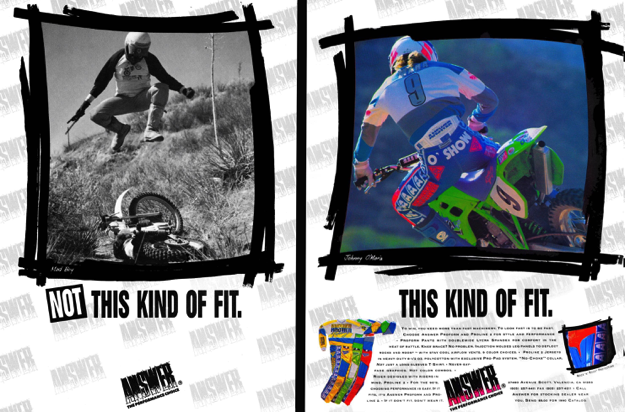 |
|
After a tough 1989, Micky Dymond was let go by Team Yamaha and Johnny O’Mara once again took over as Answer’s marquee star. After a rough few years at Suzuki, O’Mara himself was nearly without a ride for 1990, and had to be bailed out by his buddy Jeff Ward, who convinced Kawasaki to give the 1984 Supercross champ one last factory ride. Matthes: O’Show looked good on Kawi and Answer in 1990! I actually liked those green Gator pants he used to wear and more than anything when I look at this ad, I think about the cost of a two page ad for Answer where one page isn’t used to sell anything. Clearly the money was rolling in at Answer at this point. |
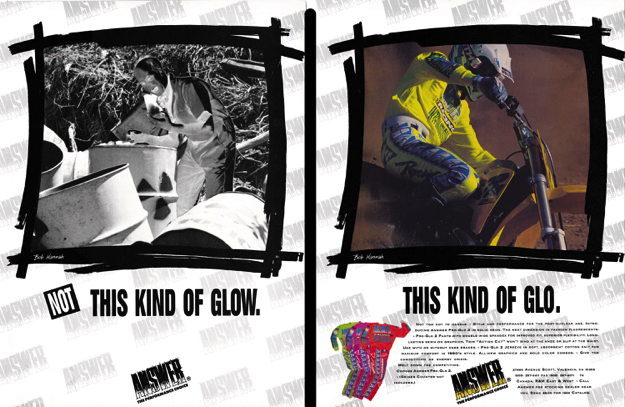 |
|
In their ads for 1990, Answer chose to go with these interesting two-page layouts that each featured a different play on words. While clever, I never thought they were particularly effective at highlighting the product. As to the gear itself, it was virtually identical to 1989, with the sole significant change being this new monochromatic Pro-Glo 2 jersey and pants. Matthes: Yeah, I agree it’s not a great look to highlight the new gear right? Even the photo of Hurricane doesn’t really highlight the gear. This is four years after he retired but Hannah still out there selling stuff. Shows you his Q rating was still strong. |
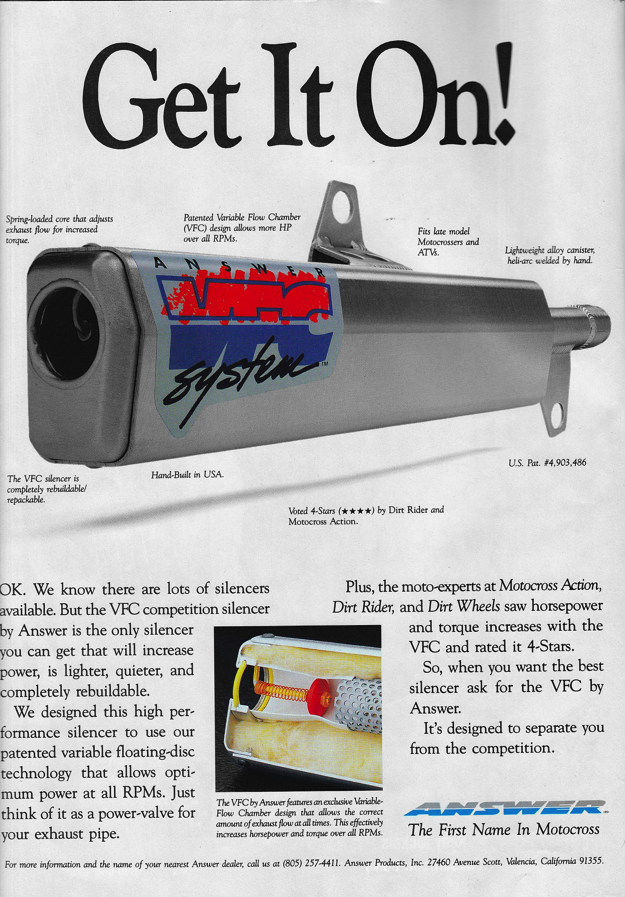 |
|
For 1990, Answer continued its hard parts innovation with the introduction of their new VFC (Variable-Flow Chamber) muffler. When I first saw the VFC I thought this thing was so trick and a great idea for riding in areas where sound was an issue. In spite of great magazine reviews, however, it never seemed to catch on. Maybe it was a total gimmick, or maybe it was just too big and bulky-looking for the average fashion-conscience motocross rider. Regardless of the true reason, the VFC would only last in the Answer lineup for a few short years. Matthes: I never ever saw one of these in person. I have no further comment. |
 |
|
For 1990, Answer maintained its affiliation with Honda and continued to offer a version of their Proform gear as a TX-10 branded Honda accessory. In the ad above, you can see Honda’s Mike Kiedrowski modeling the Answer version on top, with the less attractive (in my opinion) AXO Sport version on the bottom. Matthes: The Hondaline thing was so confusing. Stanton wore Answer and AXO but I think Kiedrowski always stuck to the Answer stuff. I don’t think I ever saw any factory guys wear the stuff in the bottom of this ad. Also, this stuff never made it across the border into Canada so I never saw it. |
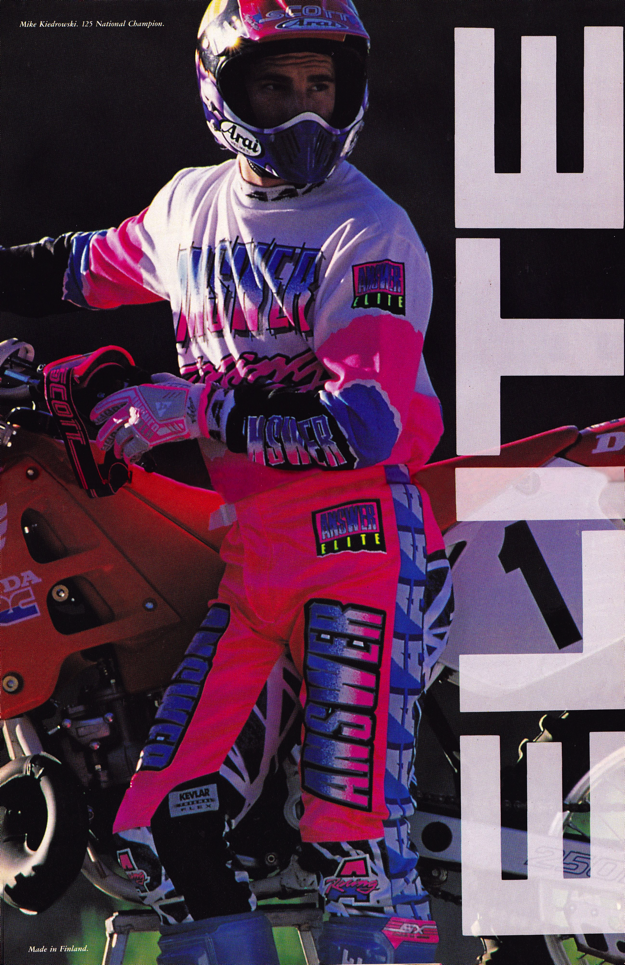 |
|
In late 1990, Answer introduced their new Elite line of gear and good lord I HAD to have it. As if things were not already bright enough in the gear world, the new Elite line cranked the neon quotient up to eleven. The pink, yellow and green colorways in particular were positively retina searing. With new advances like heat-resistant Kevlar for the kneepads and ultra-wide spandex for the seams, the new Elite pants were also more comfortable than ever. Even today, I love the look of this gear. Matthes: Blazier’s right, this stuff is sharp and it was everywhere in Canada thanks to R&M, the Canadian Answer distributor, seemingly pumping the market full of it. The wide spandex on the leg and Kevlar on the knee was what AXO had been doing for a few years and it worked. I did not have this stuff (I was AXO guy in ’90) but my buddy Curt had, like, every color of this stuff on his RM. |
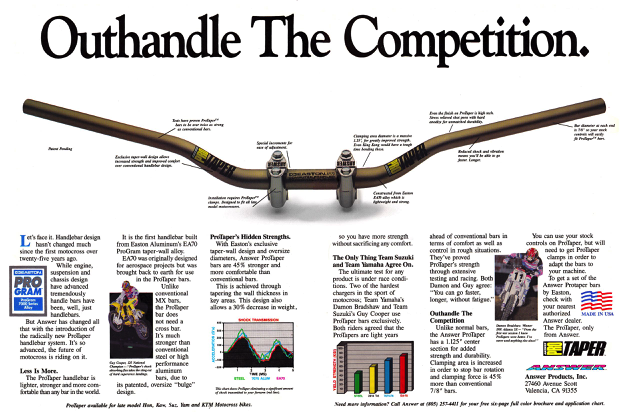 |
|
In 1991, Answer partnered with aluminum manufacturer Easton to produce the world’s first oversized crossbar-less handlebar. Using Easton’s EA70 aluminum bat technology, Answer was able to both reduce weight and increase strength over a conventional alloy bar. The new Pro Taper was not just stronger, it was also more comfortable, as the tapered design allowed for more flex on hard hits. At the time, its only real drawback was cost, as switching to the new bar required the purchase of a whole new upper clamp to accommodate its larger 1-1/8” diameter. Matthes: A real game changer in the sport of motocross, I remember seeing photos of Bradshaw with this on before it came out and being mystified about where the eff was the crossbar? Real cool invention and to me, partnering with Easton was very key because people knew that brand knew aluminum and was a huge mainstream name. Just gave it some credibility to me. |
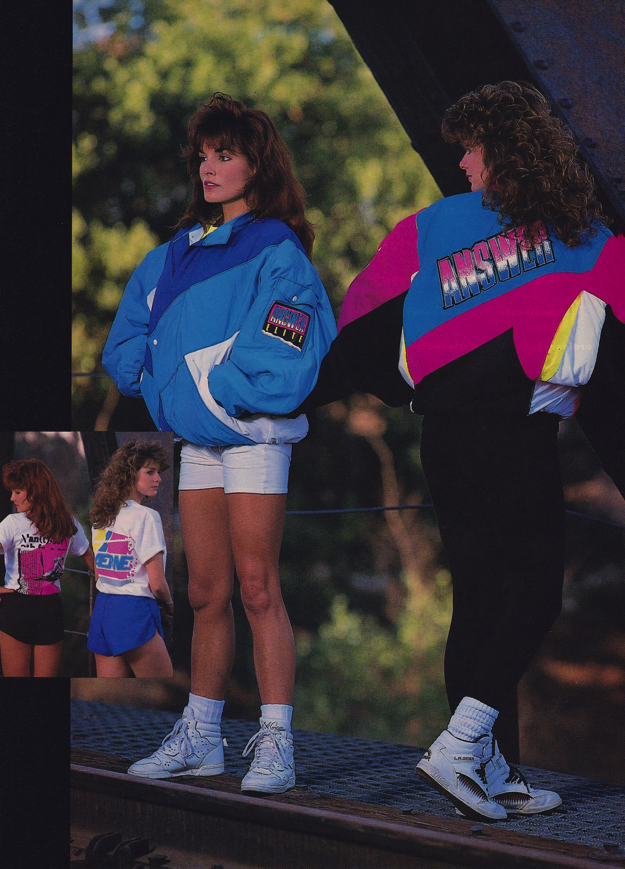 |
|
Puffy jackets were a thing in 1991 too. Matthes: So was big hair. This is ’91 but it could easily be 1987. |
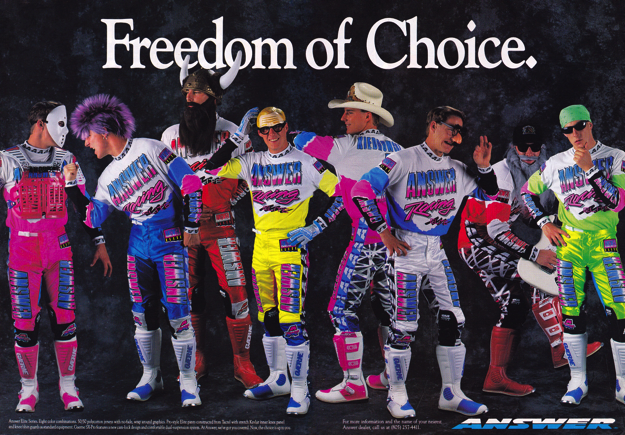 |
|
With O’Show’s retirement at the end of the 1990 season, Mike Kiedrowski moved to the top spot in Answer’s lineup. Usually a pretty restrained personality off the track, this Answer ad from 1991 did allow Mike to show a little of his lighter side while showcasing the new Elite lineup. My favorites were pink, blue and yellow (I still have a set of the yellow in my collection), but all of them looked pretty badass in 1991. Matthes: Mike Kiedrowski, while a hell of a nice guy and a massively underrated rider, didn’t have a lot of that personality to sell gear, but Answer did try hard with him. I just don’t know if he ever connected with people like Bradshaw or Chicken, or even Cooper. The back of these pants always reminded me of Eddie Van Halen’s famous guitars. |
 |
|
The arrival of gel-printing to the motocross world in the early nineties meant jerseys could be more colorful and vibrant than ever. Unfortunately, this print process also made them virtually impervious to airflow. When you added in the sweet terrycloth cuffs and cozy turtleneck collar, you had a recipe for a nice heat stroke my friends. In the summer, these puppies were absolute hot boxes and many of us resorted to cutting holes in them to try and get a little airflow. Still, they did look mega-sweet, and it is always better to look good than to feel good anyway. Matthes: I do not remember this ad at all. Weird. I do remember that gear because I have a sweet photo of Ross “Rollerball” Pederson (who wore Answer for about ten years) wearing this stuff on his Suzuki’s. Blazier’s right, this era of motocross gear is amazing simply for the fact we didn’t have more guys dying of heat exhaustion. I have an Xtreme jersey from 1996 that weighs 20 pounds and doesn’t vent at all. |
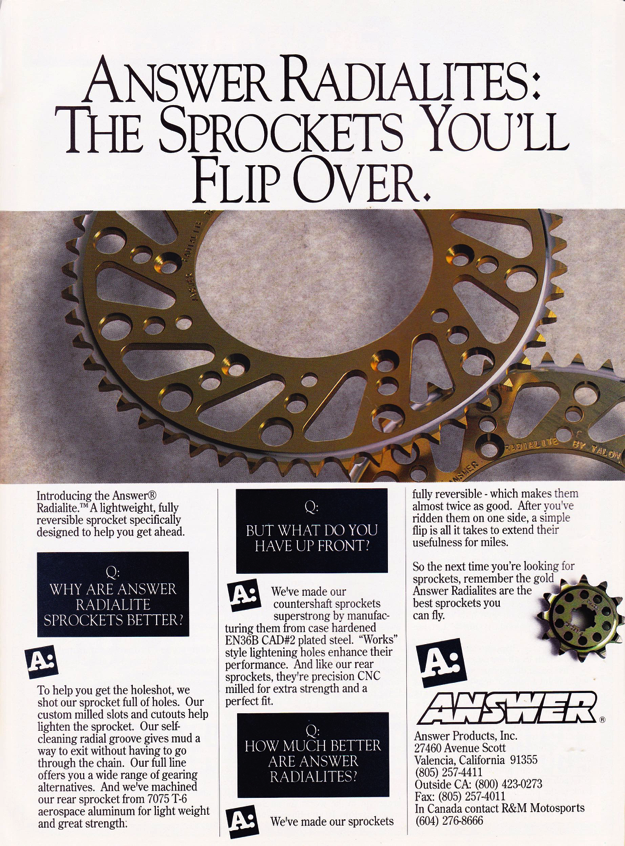 |
|
In 1992, Answer took on another one of Renthal’s products by introducing their own line of sprockets. Coined the “Radialite”, Answer’s version was damn cool looking and actually reversible, so you could try and milk a few extra motos out of them before popping for a new one. Matthes: I had one or two of these and I remember they didn’t last very long and were super light. They also had cool packaging if I remember right. |
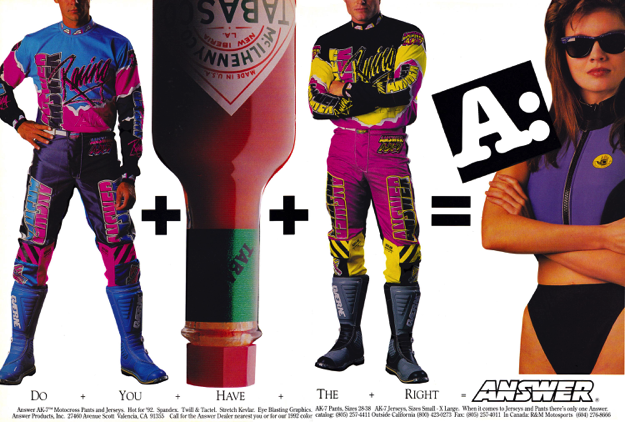 |
|
What exactly was this ad saying? Is it some kind of kinky endorsement of food fetishes and threesomes? Dude + hot sauce + dude = hot chick in wet suit? Honestly, I don’t get it. Peculiar metaphors aside, I dug Answer’s new AK-7 gear for 1992; it was ultra-colorful and attractively designed. About my only quibble was with the odd stripes on the knees, which reminded me of the handle on a jet fighter ejector seat. Eject Mav, eject! Matthes: Oh wow. Blaze is right…what in the hell does this even mean? Who designed this? Why is there a chick with Body Glove wetsuit top? Moving on… |
 |
|
For 1993, Answer introduced three new lines of gear and I have to admit, I didn’t much care for any of them. The new Apex line featured an interesting sort of “digitized” look that wasn’t my cup of tea. None of the color combos were to my taste either. I’m sure some people loved it, but for me…meh. Matthes: We’re starting to get to the point where you couldn’t tell the different Answer lines from one year to the next. I know people who had this jersey and ran it with the other line of pants. Keefer would’ve had a heart attack. |
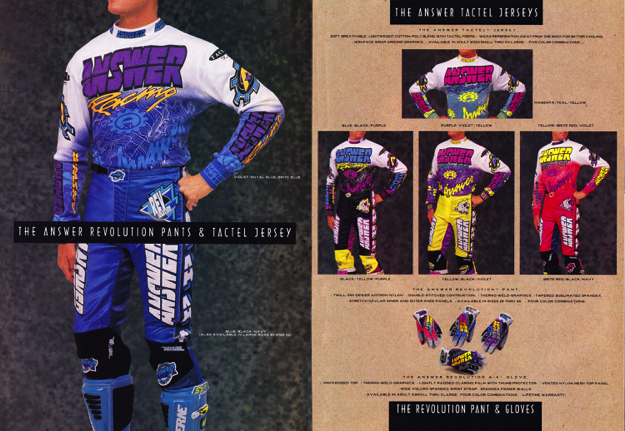 |
|
Gears people, GEARS! Yeah, I did not like the Revolution line either. While I did not care for the look, the new Tactel jerseys were at least comfortable. Much softer and more breathable than the gel prints, the Revolution line did a pretty good job of keeping you cool. Matthes: I think you gotta give Answer some credit here. Nowadays, the gear guys have three or four different lines of gear with different features, designs, and price points to satisfy just about everyone. Back in the early 90’s, I don’t think many companies did that. Props to Answer on that. |
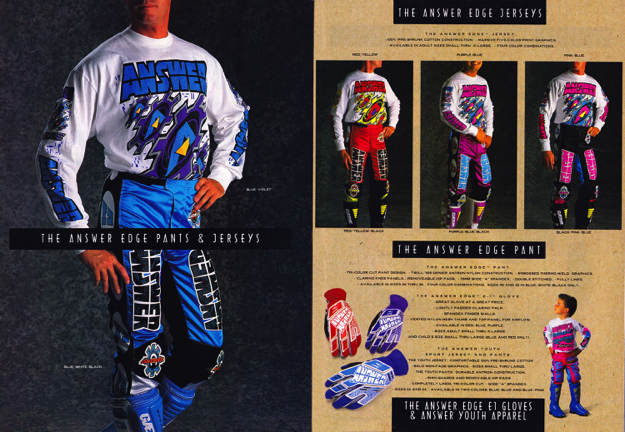 |
|
Ah look, more gears. While I am not a fan of the look, I must say I do miss the good old 100% cotton jersey. Yes, it is not as moister-wicking as modern materials, but I always loved the feel of a nice cotton jersey. Oh well, maybe I am just old. Matthes: Better to have the cotton than the Gel-print 20-pounders Blaze. |
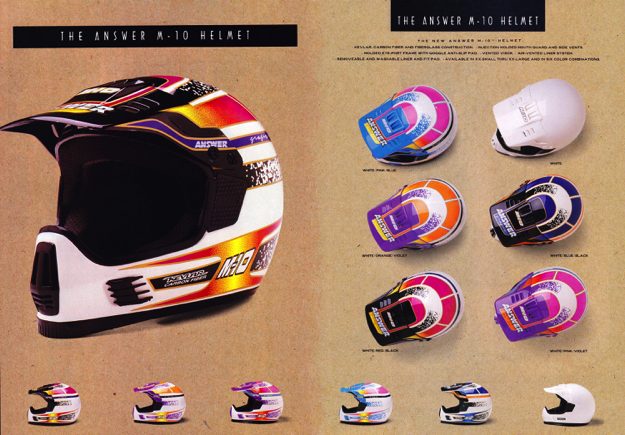 |
|
In 1993, Answer retired their Bell-made Tek-4 and introduced their own high-tech helmet dubbed the M-10. Using a carbon-fiber/Kevlar construction, the M-10 was very cutting edge for the era. That said, I never saw any of their sponsored riders actually wear one. Matthes: I never saw one of these in person, ever. |
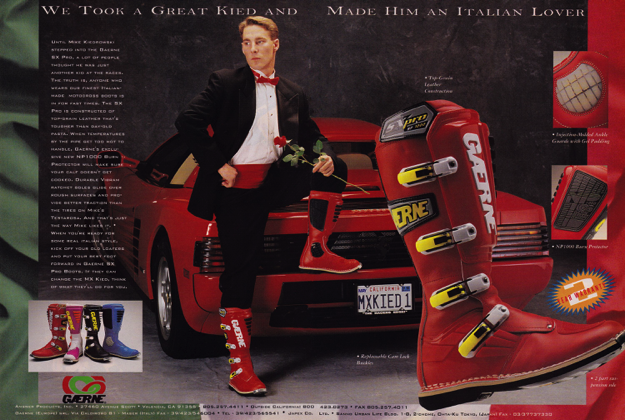 |
|
Answer continued their partnership with Gaerne throughout the nineties and delivered some of the best ads of the era. This one in particular starring Mike Kiedrowski is still one of my favorites. Matthes: A cool ad, but a bit of a rip-off of the Wardy Sinisalo one from years earlier, where he was chilling in front of his Porsche. Anyways, these boots were good in 1984, they were good in 1993 and they’re still good in 2017 dammit. Was this Mike’s car thought? He doesn’t seem like the type to blow money like this. |
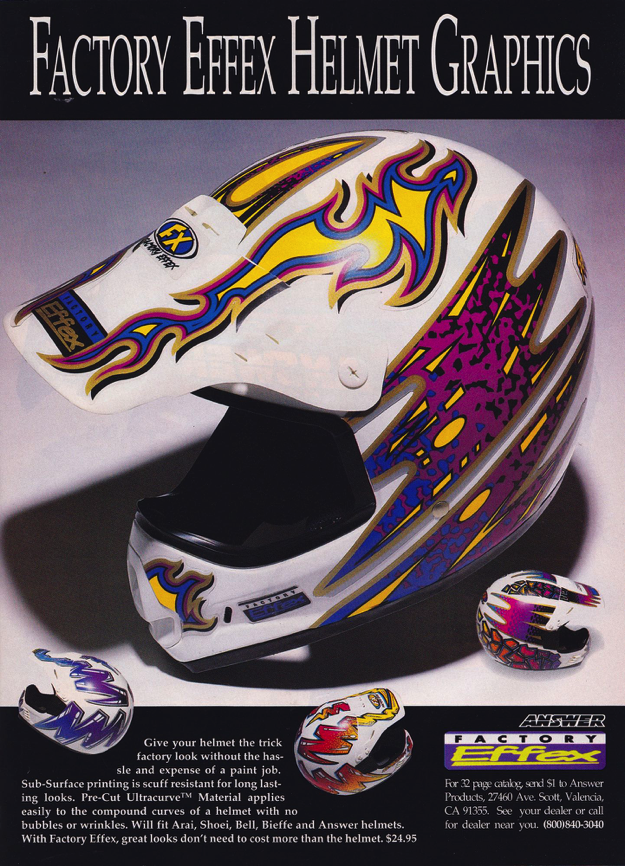 |
|
One of the trends that became big in the nineties was the availability of inexpensive helmet graphics. If you could not afford that $500 custom paint job, at least you could buy a $30 set of graphics from Answer spin-off Factory Effex and cure that cue-ball-itis. Matthes: Yeah for a while there were tons of different companies selling helmet sticker kits. I don’t think these were that cool though. |
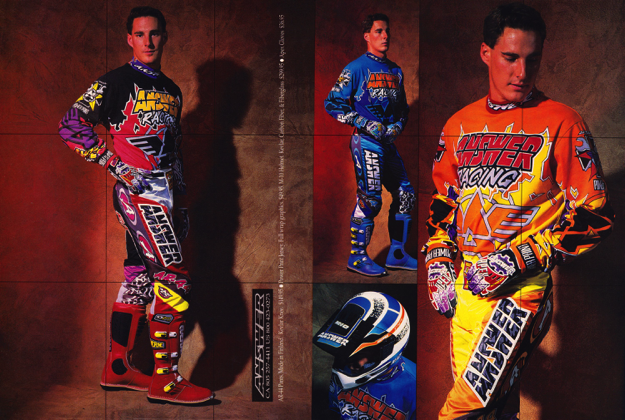 |
|
In 1994, Answer ditched the AK-7 line and introduced the new AR-44 (first the chick with the Uzi, then AK and now AR, am I the only one who thinks someone at Answer had a thing for Cold War era machine guns?) line. While still not my favorite of their designs, I am a sucker for orange and would have ran the heck out of that gear on the right. Matthes: See what I’m talking about? There is not a whole lot different going on here for Answer from year-to-year. That thing below the Answer on the jersey looks like something out of Germany. |
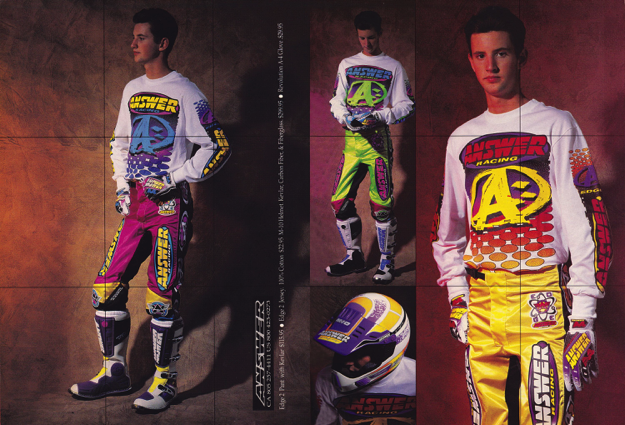 |
|
Yeah, still not loving the Edge gear, but at least a baby-faced Damon Huffman makes it look almost cool…almost. Matthes: “Hey Huffy, get over here and model the $100 stuff ok?” |
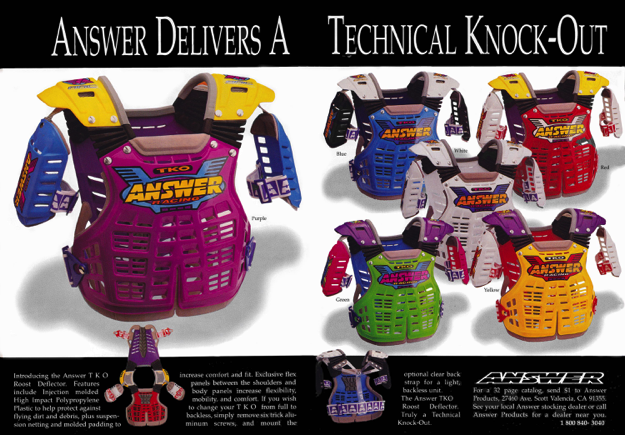 |
|
In 1994, Answer introduced a new “Roost Deflector” (apparently, chest protector sounded too protective?) they coined the TKO. OK, who in the heck thought it was a good idea to name their protective gear after anything having to do with being knocked out? I mean, seriously? Does this seem like a good idea? At least they were colorful; I will give them that. Matthes: I did like those little black shoulder pivot things that kind of folded up and adjusted as you moved. Taking the arm protectors off of all chest pro’s was the cool “pro” move. |
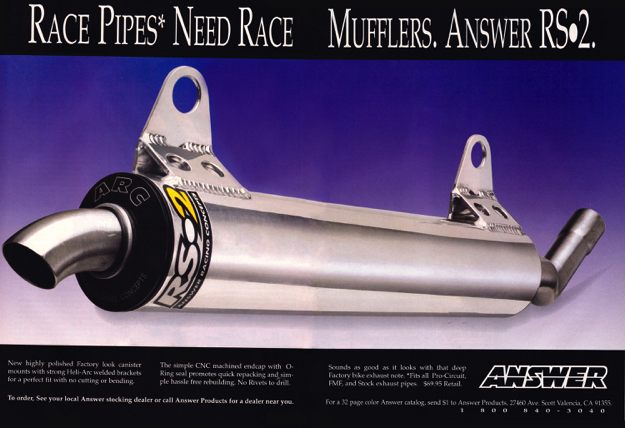 |
|
After retirement of the successful Equalizer line and fizzling of the lackluster VFC, Answer was looking for a new silencer to recapture lost glory in 1994. The result was the new RS-2 and man it was one sweet piece of hardware. This new $69.95 silencer was highly polished and super trick. I had one on my CR250R and man it gave the bike a nice throaty bark. As a side note, safety be damned, I really miss these old-school turned-down tips. Matthes: You wouldn’t miss those turned down tips if you were cut in the wiener like my buddy Darrell was, Blaze. Yeah, a PC silencer got him right in the package and stitches were required. I like those brackets being drilled out on the mounts. I never, ever saw one of these in person. |
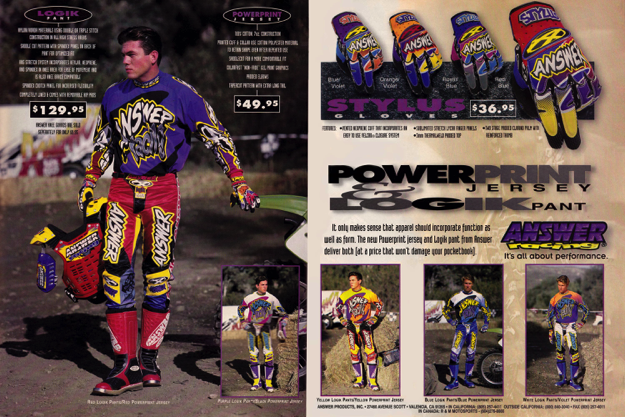 |
|
For 1995, Answer dropped the firearm references and decided instead to go with some alternate spelling. The new Logik pants and Powerprint jerseys were bright, bold, and easily my favorite Answer gear since the Elite line in 1991. In particular, I loved the new logo design and interesting color combos. Yellow, purple and orange? Yes, please. Matthes: Finally Answer changes up the “Answer” logo! Hooray! I’m not mad at this stuff; it kind of suits the era really. |
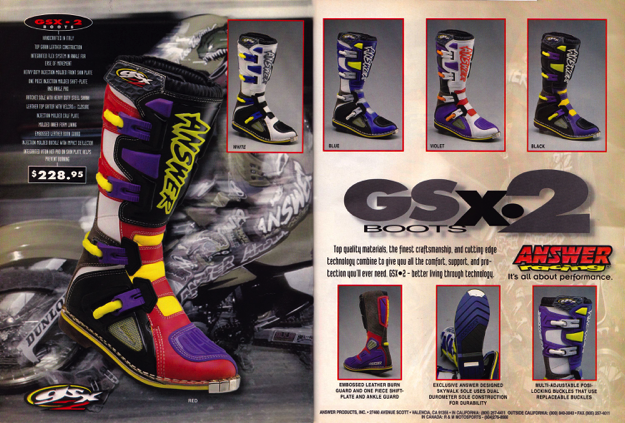 |
|
In 1995, Answer also added a premium boot to their lineup, the new GSX-2. Built for Answer by Gaerne in Italy, the GSX-2 offered slightly different styling and a lower price than the top-of-the-line Gaerne offerings. Matthes: I do not remember these or ever saw these in person. Again though, Answer was trying to offer up a lower priced boot that you know was still made well, so props to them. |
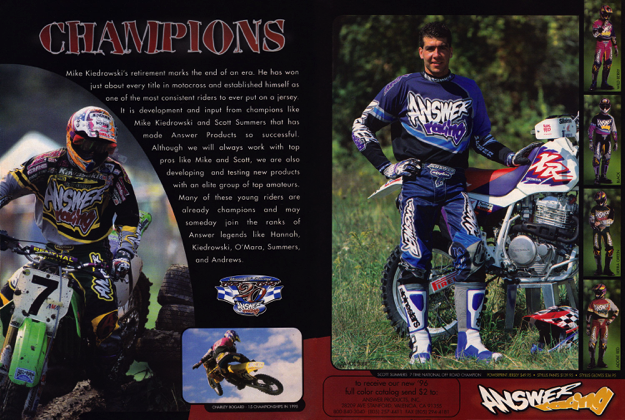 |
|
With the surprising retirement of Mike Kiedrowski and Damon Huffman’s defection to AXO, Answer was left without a marquee rider for their 20th anniversary year in 1996. While some ads promoted privateer riders like Scott Sheak and amateurs like Charlie Bogard, the main thrust of their ads shifted to GNCC hero Scott Summers for the next few years. Matthes: Oh man, not a good choice to promote a guy who raced an XR600 in MXA ads over and over. I mean, Summers was a bad dude for sure but MX people weren’t going to clamor for your gear if you’re pumping an off road dude on a four-stroke. Blaze is right though, they went in with Sheak, Bogard and somehow, Shaun Perolio got some full-page ads from Answer. |
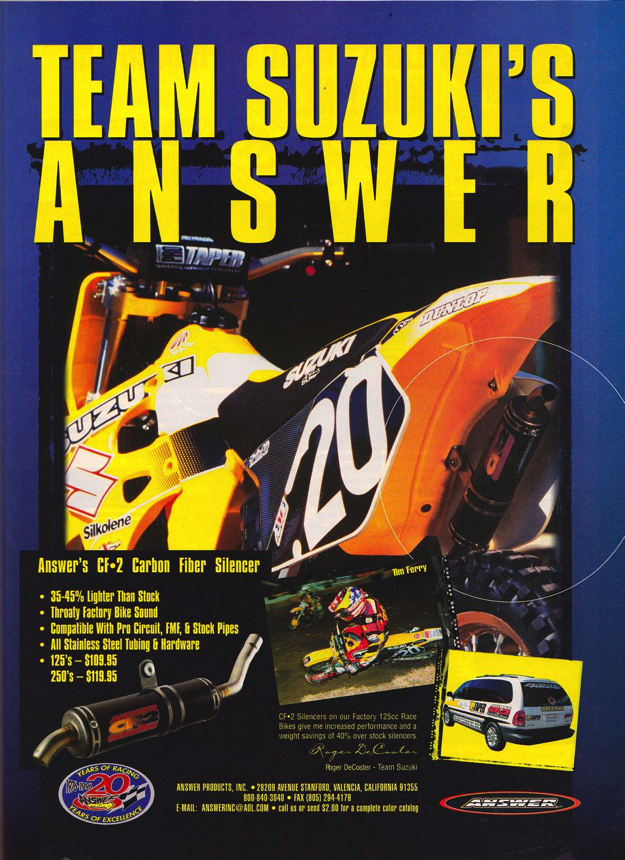 |
|
In 1996, Answer was still a major player in the hard parts business. They offered a full line of silencers (including this ultra-badass carbon CF-2 silencer used by Team Suzuki), filters, clutch plates, brake pads, and of course, handlebars. Even though this part of their business was still very successful, it was quickly being eclipsed by the runaway success of their mountain bike accessories division. With production demands already at 110% of capacity, Answer would need to start making some tough decisions regarding their product priorities. Matthes: I’ll have to ask Berluti but I don’t think these were ever the official silencer of Team Suzuki. Not sure what happened but that is a great photo of Tim Ferry in this ad so I’ll say these were probably awesome. |
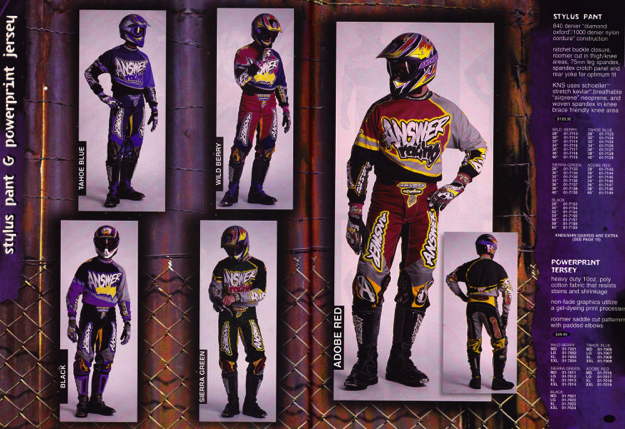 |
|
After everyone misspelled Logik in 1995, it was time to introduce Stylus for 1996. The new Stylus pants and Powerprint jerseys looked very similar in design to the year before, but offered a more subdued earth tone color pallet. Matthes: I remember thinking that Answer was a few years late with these colors because Fox had done it a few years earlier. It was very cool and unique when it first came out but kind of done when Answer jumped on board. |
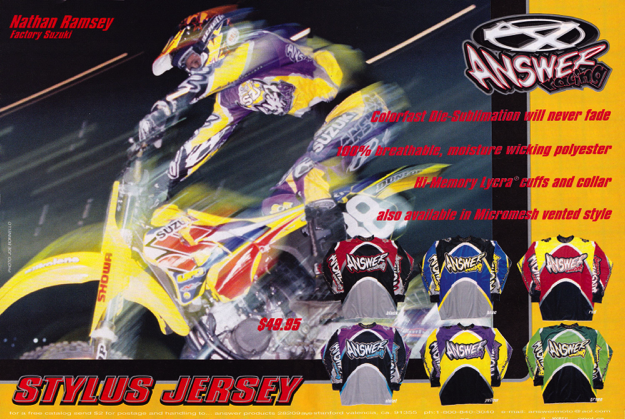 |
|
The 1997 season brought with it a return to bright colors and the addition of Factory Suzuki’s Nathan Ramsey as the premier Answer motocross rider. The purple and yellow combo was a good look. Matthes: Really? Nate Dog was their guy in ’97? Now that I think of it, I can’t remember anyone else ever wearing this stuff so I guess that’s true. |
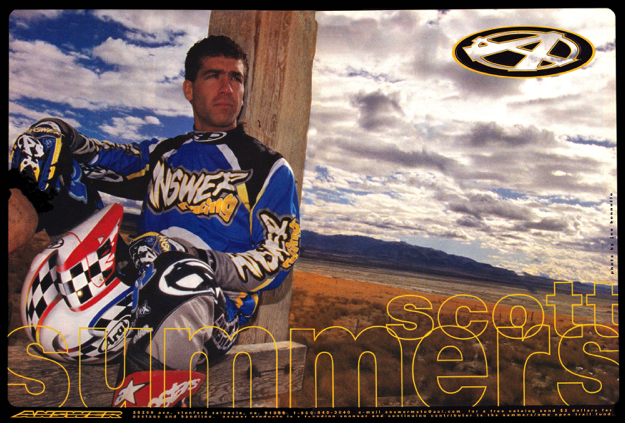 |
|
Any guy who can dead lift an XR600R is OK by me. Matthes: Yeah, agreed. Do not mess with this guy. Nowadays, if a gear company had a rider with a different brand’s helmet, they would NEVER feature it prominently like Answer is doing here with Arai. Companies are way more dick-ish to each other. I’ve heard of companies choosing photos for their ads that have the top of a helmet out of the shot to not give those sponsors any coverage. |
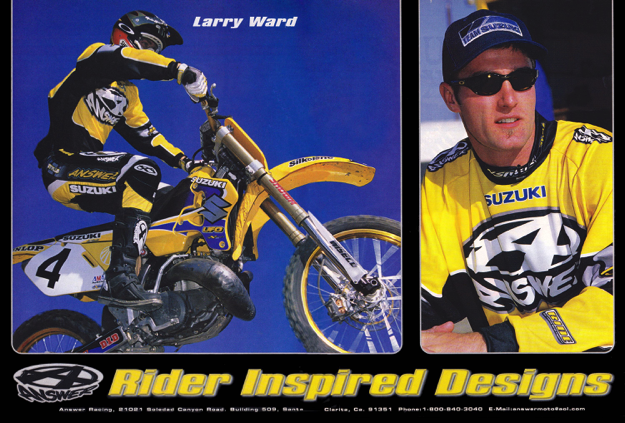 |
|
For 1998, Answer picked up Suzuki star Larry Ward as their star motocross athlete. Matthes: Add Answer to the list of gear companies that Big Bird rode for. Let’s see here…we’ve got Gear, HondaLine, Fox, JT, Taichi, Xtreme, Sinisalo, Answer again, and then O’Neal. He did win the muddy Tampa SX in this stuff though! |
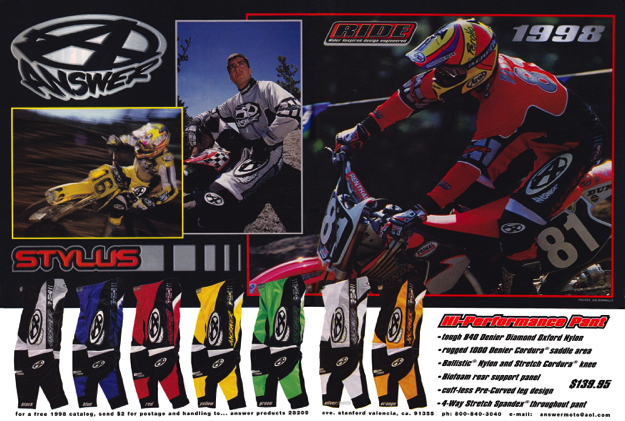 |
|
After the bold colors and crazy designs of the early nineties, most gear became much more subdued toward the latter part of the decade. For 1998, Answer’s Stylus line continued, but the overall look was cleaner and less flashy than before. Matthes: I like the circled “A” logo, it’s a nice change like Blaze was saying from the Answer that was on the pant for a decade. I mean, it’s not like they’re changing the name of the company by dropping a couple of letters, or something like that. That would be dumb. |
 |
|
By 1998, Answer had shut down most of its motorcycle hard parts operations in favor of boosting mountain bike accessories production. With the Roost Boost and silencers round-filed, the lone survivor turned out to be the product that had put them on the map twenty years earlier – handlebars. The Pro Taper bar lived on and turned out to be so successful that Answer decided to spin it off as its own brand. Today, Pro Taper offers a full line of bars, sprockets and accessories including, ironically, a 7/8” inch SE (for Seven Eights) handlebar. Matthes: Yamaha was on the Pro Taper bandwagon way early and used them from ’91 to shuttering it’s factory team in, I think, 2007. That’s a long time to run something, but they always had a good relationship with not having a crossbar. The factory team is back now with Webb and Reed, but they’re using Renthal’s. The end of an era. |
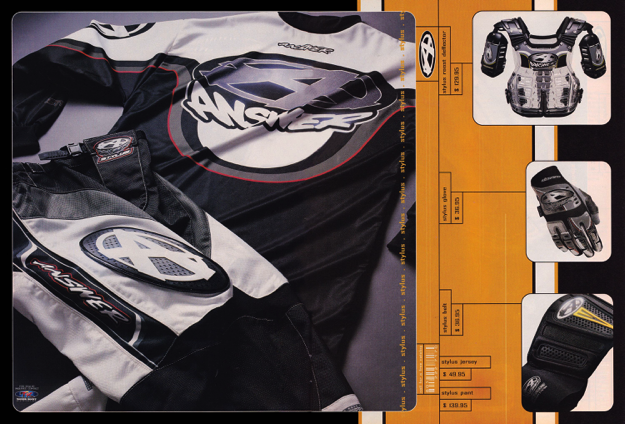 |
|
If the decade of the nineties came in with a neon-colored bang, it certainly went out with a monochromatic fizzle. Clean and uncluttered, the ’99 Stylus gear was good looking, but not particularly exciting. Matthes: Why get rid of the large stretchy band on the side of the leg though? Didn’t “we” like that? |
If you like this and would like to see us do more like it, drop me a line on twitter @tonyblazier or via email at TheMotocrossVault@Gmail.com
For your daily dose of old-school moto goodness, make sure to follow me on Instagram -@TonyBlazier.




